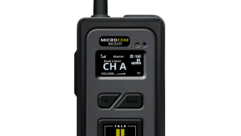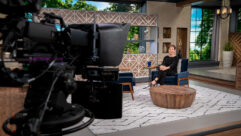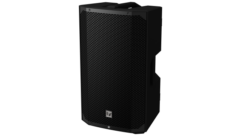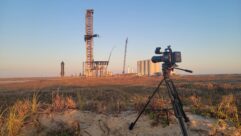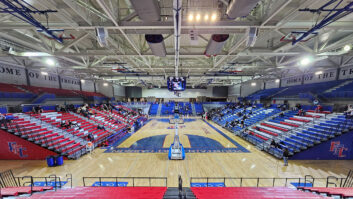WIRE FOR EVERYDAY USE
Aug 1, 1998 12:00 PM,
Glen Ballou
Today, we have many ways to connect two electronic devices. We have fiberoptics, high frequency RF, microwaves, infrared, satellite transmissionand, oh yes, wire. It was only 25 years ago that wire was the onlypractical method. Why would we ever want to use an old and obsolete methodto connect our system when we have all of the new and modern methodsavailable? A few reasons come to mind. Any time we add a second componentor multiple components to a system we decrease reliability; wire is areliable and simple component. It is also usually the least expensivemethod of connection. It is harder to break into a hard-wired circuit thanone that is transmitting over the airwaves. Shielded wire almost always hasa better signal-to-noise ratio than other methods that require extracircuitry. Moreover, wire is not usually affected by storms and two-wayradios. Lastly, a piece of wire is about as simple a connection as we canmake, and remember, simplicity rules. I’m sure we can come up with manymore, but you get the point, wire has been around for a long time and willbe around for a long time to come.
Of course, there are certain things about wire that we cannot overlook. Allwire has resistance which dissipates power through heat. At highfrequencies, wire unloads, and reflections and losses are created. Wire canbe difficult to run in buildings that have already been constructed, andwire can be cut or broken.
Effects of wire sizeWire is usually sized by the American Wire Gauge (AWG) method. The wiremost often used in audio ranges from number 4 to number 24. Wire biggerthan #4 is heavy and cumbersome while wire smaller than #24 is extremelyfragile and has high resistance.
The resistance for a given length of wire is determined by:
Consult Printed Publication for Formula
where R is the resistance of the length of wire in ohms, K is theresistance of the material in ohms per circular mil foot, L is the lengthof the wire in feet and d is the diameter of the wire in mils.
Wire size is important when running loudspeaker lines or any line carryingpower a long distance because the wire is in series with the load orloudspeaker. The power to the load or loudspeaker can be determined withthe equation:
Consult Printed Publication for Formula
where, PT is the total power in the circuit, I is the current in thecircuit, R1 is the resistance of the wire, R2 is the resistance of theloudspeaker, and PR is the power in the loudspeaker.
For instance, if an 8 V loudspeaker is connected to an amp 500 feet (152 m)away through a #19 wire, the total wire resistance would be 8 V; therefore,50% of the power would be dropped in the wire through heat. By using #16wire, only 33% of the power would be lost as heat.
A handy rule of thumb is to remember is that 1,000 feet (305 m) of singleconductor #16 wire has a resistance of about 4 V. This is only one way, soa loudspeaker 500 feet (152 m) away from an amp has a total wire length of1,000 feet (305 m). Each time the wire size changes three numbers (likefrom #16 to #19 or #13), the resistance doubles or halves.
Many of the hi-fi magazines talk about loudspeaker wire and its effect onsound quality. Discussions on impedance, inductance, capacitance,resistance, loading, matching and surface effects are constantly argued.Most home loudspeaker runs are short (less than 50 feet (15 m) andtherefore do not constitute a transmission line.
To consider the loudspeaker cable as a transmission line, we would have toanalyze it as to characteristic impedance and the arrival time differences.An excellent article by R.A. Greiner, “Cables and the Amp,” appeared in theAugust 1989 issue of Audio. Greiner stated that the characteristicimpedance of a transmission line is:
Consult Printed Publication for Formula
where R is the line resistance per unit length, L is the series inductanceper unit length, C is the shunt capacitance per unit length and G is theshunt conductance per unit length. Normally G is 0 for loudspeaker cables,so for high-audio frequencies where L is much greater than R:
Consult Printed Publication for Formula
For low frequencies where L is much smaller than R:
Consult Printed Publication for Formula
This is the expression normally used for loudspeaker lines, and occurs atthe frequency:
Consult Printed Publication for Formula
which is between 15 kHz and 500 Hz, depending on the size of the wire. Tohave a distortionless transmission, the following equation must besatisfied:
Consult Printed Publication for Formula
Because G is 0 for audio cables, R and C should be as small as possible,and L should be much larger to make a good transmission line. To determinethe arrival time differences created by the line, where G = 0, use theequation:
Consult Printed Publication for Formula
where Vp is the velocity of propagation, f is the frequency, C is thecapacitance, R is the resistance, L is the inductance and v is 2p. As canbe seen, there is very little arrival time difference in the audiofrequency range. This means that loudspeaker lines should not be calculatedas transmission lines.
If we consider the loudspeaker cable as a lump sum, Figure 1, a much morepractical solution, we find that the impedance of the line varies with wiresize and type. Table 1 gives typical values of R, C, and L for 10 m (32.8ft) long cable. Note, the impedance at 20 kHz is low for all but thesmallest wire, and the -3 dB upper frequency is well above the audio range.The worst condition is with a capacitive load. For instance, with a 4 mFload, resonance occurs around 35 kHz, still well above the range of hearing.
For best results for short amp to 4 V or 8 V loudspeaker runs we shouldmake the amp to loudspeaker runs as short as possible, use a wire size thatrepresents less than 5% of the loudspeaker impedance at any frequency, usetwisted pairs to eliminate crosstalk (amp output is often fed back into theamp as negative feedback, and use good connectors to reduce resistance.
An article, “To Tweak, or not to Tweak?” in the June 1998 issue of StereoReview, tested quality loudspeakers with high quality components, includingwire, and the same loudspeakers with poor quality components, includingwire. A panel listened to the two systems and the outcome was that theycould not decisively tell which system was which. Obviously the loudspeakerhas much more effect on what we here than the other components. Again,special wire is usually not needed.
Of course, everybody talks about “damping factor,” and we can buy ams withdamping factors exceeding 500. But what does this mean? The damping factoris determined by dividing the loudspeaker’s AC impedance by the amp’simpedance, or so it would seem. If this were true, a loudspeaker with animpedance of 8 V connected to an amp with an output impedance of 0.01 Vwould have a damping factor of 800. This would certainly help to controlthe movement of the loudspeaker. However, loudspeakers have a DC resistancein series with its AC impedance, which has to be added to the ampimpedance. An 8 V loudspeaker often has a DC resistance of 6 V, thereforethe damping factor for the system would be 1.33, a far cry from what weexpected. Of course, we have to add the resistance of the wire to theequation, but as can be seen, a few tenths of an ohm is small compared tothe DC resistance of the loudspeaker, so it is not going to change thedamping factor appreciably. The bottom line is that wire size probably doesnot effect the quality of sound on short runs and 8 V loudspeakers.
When runs are longer or many loudspeakers are connected to a line, it iscommon to connect the loudspeakers as a 70.7 V, 100 V or even a 200 Vsystem to reduce the line loss we encountered in the previous 8 V system.For instance, if a 4 V loudspeaker is connected to an amp with a cable,which measures 4 V, 50% of the power will be dissipated in the cable. Ifthe loudspeaker were to be connected to a 70.7 V system, and theloudspeaker were taking 50 W from the amp, the loudspeaker/transformerimpedance would be 100 V; therefore, the 4 V line loss would dissipate only4% of the power.
When using a 70.7 V loudspeaker system (commonly called a 70 V system), thechoice of wire size for loudspeaker lines is determined by an economicbalance of the cost of copper against the cost of power lost in the line.Power taken from the amp is calculated from the equation:
Consult Printed Publication for Formula
or for a 70.7-volt system:
Consult Printed Publication for Formula
If voltage is 70.7 V and the load is 50 V, the power would be 100 W.However, if the amp was connected to a 50 V load with 1,000 feet (305 m) ofAWG#16 wire (2,000 feet or 610 m round trip) or 8 V of wire resistance thepower from the amp would be:
Consult Printed Publication for Formula
The current through the system is:
Consult Printed Publication for Formula
The power to the 50 V load would be:
Consult Printed Publication for Formula
Or, 26% less power than assumed. Only 11.7 W are lost because of the wireresistance; the other 14 W cannot be taken from the amp because the totalimpedance of the loudspeaker/cable is more than 50 V. Loudspeaker cable orwire size does make a difference, but not to the extent that some of thewire manufactures would like to make you believe.
Shielded cableMany installations require shielded cable to eliminate noise entering thesystem or signal leaving the system. Braid shields provide superiorstructural integrity and are flexible and exhibit good flex life. Theyminimize low-frequency interference and have low DC resistance. Braidshields are effective at audio and RF ranges. Generally, the higher thebraid coverage, the more effective the shield.
A foil shield consists of aluminum foil laminated to a polyester orpolypropylene film. The film gives the shield mechanical strength and bonusinsulation. Foil shields provide 100% cable coverage. Foil shields arecommonly used to shield individual pairs of multi-pair cables to reducecrosstalk. They have less weight and bulk. They also cost less than braidshields and are generally more effective in RF ranges. Drain wires are usedwith foil shields to make termination easier and to ground electrostaticdischarges.
A shorting fold technique is often used to maintain metal-to-metal contactfor improved high-frequency performance. Without the shorting fold, a slotis created where the foil overlaps through which signals can leak.
Combination shields consist of more than one layer of shielding. Theyprovide maximum shield efficiency across the frequency spectrum. Thecombination foil-braid shield combines the advantages of 100% foil coverageand the strength and low DC resistance of a braid. Other combinationshields available include various foil-braid-foil, braid-braid, andfoil-spiral designs.
Cable jacketsAudio and broadcast cables are manufactured in a wide selection of standardjacketing materials. The jackets determine the flexibility of the wire andits resistance to the environment, especially at low temperatures. Propermatching of cable jackets to their working environment can preventdeterioration due to intense heat and cold, sunlight, mechanical abuse,impact and crowd or vehicle traffic. Jacketing comes in many compounds,including polyvinyl chloride (PVC), polyethylene, Teflon, Neoprene,Hypalon, silicon rubber and natural rubber, enable the user to meetspecific requirements with appropriate cable designs.
Rubber jacketing compounds feature exceptional durability for extendedcable life. They withstand high-impact and abrasive conditions better thanPVC and are resistant to degradation or penetration by water, alkali oracid. While exhibiting excellent heat resistant properties, rubber jacketsalso provide greater cable flexibility in cold temperatures.
Vinyl, often referred to as PVC or polyvinyl chloride, cannot be producedto work in extremely high or low temperature properties in one formulation,therefore, formulations may have -55degrees C to 105degrees C (-67degrees Fto 221degrees F) rating while other common vinyls may have -20degrees C to60degrees C (-4degrees F to 140degrees F). The many varieties of vinyl alsodiffer in pliability and electrical properties fitting a multitude ofapplications. The price range can vary accordingly.
Polyethylene has good electrical insulation properties and a low constantdielectric value over all frequencies. Its flexibility is stiff to veryhard depending on molecular weight and density. The low density is the mostflexible and high density, high molecular weight formulation is rock hard.Moisture resistance and weather resistance is rated excellent.
Polypropylene is similar in electrical properties to polyethylene and isprimarily used as an insulation material. Typically, it is harder thanpolyethylene, which makes it suitable for thin wall insulations. U.L.maximum temperature rating may be 60degrees C to 80degrees C (140degrees Fto 176degrees F). The dielectric constant is 2.25 for solid and 1.55cellular designs.
Teflon has excellent electrical properties, temperature range and chemicalresistance. It is not suitable where subjected to nuclear radiation, and itdoes not have good high-voltage characteristics. The nickel- andsilver-coated designs are rated 260degrees C and 200degrees C maximum(500degrees F and 392degrees F), respectively. The cost of Teflon isapproximately eight to 10 times more per pound than vinyl insulations.
Silicone is a very soft insulation with a temperature range from -80degreesC to 200degrees C (-112degrees F to 392degrees F). It has excellentelectrical properties, low moisture absorption, high weather and radiationresistance plus ozone resistance. It typically has low mechanical strengthand poor scuff resistance.
Neoprene has a maximum temperature range from -55degrees C to 90degrees C(-67degrees F to 194degrees F). Neoprene is both oil and sunlightresistant, so it is good for many outdoor applications. The electricalproperties are not as good as other insulation material, so thickerinsulation is required.
The description of rubber normally includes natural rubber and (SBR)compounds. Both can be used for insulation and jackets. There are manyformulations of these basic materials and each formulation is for aspecific application. Some formulations are suitable for -55degrees C(-67degrees F) minimum while others are suitable for 75degrees C(167degrees F) maximum.
Mechanically induced noise in guitar cords and mic cables is a critical andfrequent concern. Triboelectric noise is generated by mechanical motion ofa cable, which causes movement in the shield of the cable with respect tothe signal carrying wire. The properties of special conductive tapes andinsulations are often employed to prevent mechanically induced noise. Cablewithout fillers, (such as shielded loudspeaker cable), is not useful formic or guitar cable because it does not have a filler; hence, it has hightriboelectric noise.
Multiconductor cablesWhen a plurality of lines carrying different programs or signals are runtogether in the same conduit or bundle, they tend to induce crosstalkcurrents into each other. When planning such a run, answers are needed forseveral questions. Must the cost be paid for shielded cables, or willtwisted pairs suffice? Should transformers be used? Should the circuit begrounded? What about capacity? What about line loss, selection of conductorsize?
Crosstalk is induced by two methods-electromagnetically due to unbalancedcoupling between circuits and electrostatically due to unbalancedcapacitance between circuits or to the conduit if it carries current andthus develops a voltage difference between one circuit and the others (orto its own or other shields carrying current). Shielded, two conductorcable has leakage between the conductors and the surrounding shield. An AWG#20, for instance, will have a leakage between 40 MV and 60 MV. If theterminating impedance is small compared to the open line characteristicimpedance, the net coupling with unshielded lines is predominantlymagnetic. If the terminating impedance is much larger than thecharacteristic impedance of the line, the net coupling will bepredominantly electric.
For least noise pickup, the two wires of a pair must be twisted, aiding incanceling pickup by transposition. In the measurements in Figure 2, allpickup was capacitive because the twisting of the leads effectivelyeliminated inductive coupling. Measurements were made on a 250 foot (76.2m) twisted pair run in the same conduit as a similar twisted pair, thelatter carrying signals at 70.7 V. The disturbing line was driven from the70 V terminals of an amp and was loaded at the far end with 125 V, thustransmitting 40 W. The figures are for 1 kHz, but the voltages measured at100 Hz and 10 kHz were one tenth and 10 times these figures, respectively.As you can see, proper termination and proper grounding are very importantfor minimum crosstalk.
Snakes or multipair audio cables were originally designed for the broadcastindustry and feature individually jacketed and shielded pairs within anouter jacket for optimum protection against mechanical destruction andsignal loss. Because they keep a number of circuits neatly together in onecovering, these cables are ideal for use as line level or mic snakes. Theywill also interconnect audio components such as console board equipment forrecording studios, radio and television stations, post productionfacilities and sound system installations. Snakes are composed of lowcapacitance insulation materials and have spiral, braid and other foil tapeshields for special interference problems. Jacket and insulation materialsmeet NEC requirements, and they are highly flexible with a low-profileappearance and cold-temperature pliability. Ease of termination andidentification and the allowance of longer cable runs with fewer singlemessy cables make it an ideal choice for many applications. Snakes comewith various terminations and can be specified to meet the your needs.Common terminations are male XLR (mic) connectors and 1/4 inch (6.4 mm)male stereo connectors on one end and a junction box with female XLRconnectors and 1/4 inch (6.4 mm) stereo connectors on the other end.
Power supply cordsPower supply cords, like other cables, come with a variety of jacketmaterials for use in various environments. Cables are often U.L. listed inthe United States and CEE listed in Europe. U.L. listings signify that allelements of these cords and assembly methods have been approved by theUnderwriters Laboratories as meeting applicable construction andperformance standards. U.L. listed has become a symbol of safety tomillions of Americans, and their confidence in it results in easier salesof electrical products. Color codes used in North America and Europe forthe three conductors are shown in Table 2.
A shielded power cord continues to be a highly effective means ofminimizing the effects of ambient electrical interference. This is animportant benefit where interference-sensitive electronic devices, such ascomputer and laboratory test equipment, are concerned. The standardshielding is a foil type, consisting of an aluminum polyester film and aspiral-wound drain wire providing 100% shield coverage and radiationreduction. In extremely high EMI and RFI environments, power cords mayrequire shield construction such as Belden’s Z-Fold, which provides 100%coverage plus another layer of 85% tinned copper braid for added protection.
Coaxial cableCoaxial cable has one conductor accurately centered inside another withboth conductors carrying the desired signal currents (See Figure 3). It isused for the transmission of television and other high-frequency signals.When using coaxial cable, the capacitance per foot must be taken intoconsideration, particularly for oscilloscope probes. The various types ofcable may be identified from their coding-“R” (radio frequency), “G” (madefor US government), – (number assigned by government approval) and “U”(universal speculation). Thus, a cable marked, RG-11A/U means radiofrequency, government approval number with a universal specification. Theletter appearing before the slash (/) is a specification modification.
Attenuation in a cable is expressed in dB/100 feet (30.5 m) and is foundwith the equation:
Consult Printed Publication for Formula
where A is the attenuation in dB/100 feet, Rt is the total line resistancein V/100 feet, e is the dielectric constant of the transmission lineinsulation and p is the power factor of the dielectric medium. Theimpedance of coaxial cable is found with the equation:
Consult Printed Publication for Formula
where, d is the diameter of conductors (center conductor for coaxial linein inches), D is the diameter of inner surface of outer coaxial conductorin inches and f is the frequency in 106 Hz. The characteristic impedance ofthe cable is equal to
Consult Printed Publication for Formula
where, e is the dielectric constant. The velocity of propagation of coaxialcables is the ratio of the dielectric constant of air to the square root ofthe dielectric constant of the insulator between the center conductor andthe outer shield, and is expressed in percent:
Consult Printed Publication for Formula
where, VL is the velocity of propagation in the transmission line, VS isthe velocity of propagation in free space, e is the dielectric constant ofthe transmission line insulation.
The outside conductor (shield) is usually connected to ground at thesource, load, bulkheads, and other intermediate points. This causes groundloops and common mode returns and introduces noise into the system becauseexternal noise is carried down the outer cable along with the signal whileonly the signal is carried down the center conductor. It is most importantthat the cable have a minimum number of grounds to eliminate ground loops,the ultimate being one ground at the source.
Where a strong radiated noise field exists, such as from broadcaststations, power lines and fluorescent lighting, triax cable can be used.Triax cable is a standard coax cable with an additional outer braid shieldinsulated from the inner shields and grounded to protect the inner shieldsfrom noise. This shield bypasses ground loop and capacitive field noisefrom the signal carrying coax and greatly improves the signal-to-noiseratio (SNR).
There are many factors effecting the choice and proper use of wire, and Ihave only shown a few. As complicated as it may seem, however, it isnothing compared to the other methods of transmitting sound from one deviceto another.


